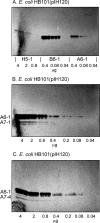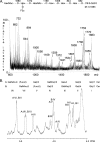Recognition of blood group ABH type 1 determinants by the FedF adhesin of F18-fimbriated Escherichia coli
- PMID: 19208633
- PMCID: PMC2665092
- DOI: 10.1074/jbc.M807866200
Recognition of blood group ABH type 1 determinants by the FedF adhesin of F18-fimbriated Escherichia coli
Abstract
F18-fimbriated Escherichia coli are associated with porcine postweaning diarrhea and edema disease. Adhesion of F18-fimbriated bacteria to the small intestine of susceptible pigs is mediated by the minor fimbrial subunit FedF. However, the target cell receptor for FedF has remained unidentified. Here we report that F18-fimbriated E. coli selectively interact with glycosphingolipids having blood group ABH determinants on type 1 core, and blood group A type 4 heptaglycosylceramide. The minimal binding epitope was identified as the blood group H type 1 determinant (Fucalpha2Galbeta3GlcNAc), while an optimal binding epitope was created by addition of the terminal alpha3-linked galactose or N-acetylgalactosamine of the blood group B type 1 determinant (Galalpha3(Fucalpha2)Galbeta3GlcNAc) and the blood group A type 1 determinant (GalNAcalpha3(Fucalpha2)-Galbeta3GlcNAc). To assess the role of glycosphingolipid recognition by F18-fimbriated E. coli in target tissue adherence, F18-binding glycosphingolipids were isolated from the small intestinal epithelium of blood group O and A pigs and characterized by mass spectrometry and proton NMR. The only glycosphingolipid with F18-binding activity of the blood group O pig was an H type 1 pentaglycosylceramide (Fucalpha2Galbeta3GlcNAc-beta3Galbeta4Glcbeta1Cer). In contrast, the blood group A pig had a number of F18-binding glycosphingolipids, characterized as A type 1 hexaglycosylceramide (GalNAcalpha3(Fucalpha2)Galbeta3GlcNAcbeta3Galbeta4Glcbeta1Cer), A type 4 heptaglycosylceramide (GalNAcalpha3(Fucalpha2)Galbeta3GalNAcbeta3Galalpha4Galbeta4Glcbeta1Cer), A type 1 octaglycosylceramide (GalNAcalpha3(Fucalpha2)Galbeta3GlcNAcbeta3Galbeta3GlcNAcbeta3Galbeta4Glcbeta1Cer), and repetitive A type 1 nonaglycosylceramide (GalNAcalpha3(Fucalpha2)Galbeta3GalNAcalpha3-(Fucalpha2)Galbeta3GlcNAcbeta3Galbeta4Glcbeta1Cer). No blood group antigen-carrying glycosphingolipids were recognized by a mutant E. coli strain with deletion of the FedF adhesin, demonstrating that FedF is the structural element mediating binding of F18-fimbriated bacteria to blood group ABH determinants.
Figures











Similar articles
-
Redefinition of the carbohydrate binding specificity of Helicobacter pylori BabA adhesin.J Biol Chem. 2012 Sep 14;287(38):31712-24. doi: 10.1074/jbc.M112.387654. Epub 2012 Jul 20. J Biol Chem. 2012. PMID: 22822069 Free PMC article.
-
The F18 fimbrial adhesin FedF is highly conserved among F18+Escherichia coli isolates.Vet Microbiol. 2005 Oct 31;110(3-4):277-83. doi: 10.1016/j.vetmic.2005.08.004. Vet Microbiol. 2005. PMID: 16169688
-
Porcine intestinal glycosphingolipids recognized by F6-fimbriated enterotoxigenic Escherichia coli.Microb Pathog. 2014 Nov;76:51-60. doi: 10.1016/j.micpath.2014.09.009. Epub 2014 Sep 18. Microb Pathog. 2014. PMID: 25241919
-
Structural insight in histo-blood group binding by the F18 fimbrial adhesin FedF.Mol Microbiol. 2012 Oct;86(1):82-95. doi: 10.1111/j.1365-2958.2012.08174.x. Epub 2012 Aug 13. Mol Microbiol. 2012. PMID: 22812428
-
F4 fimbriae expressed by porcine enterotoxigenic Escherichia coli, an example of an eccentric fimbrial system?J Mol Microbiol Biotechnol. 2004;7(4):155-69. doi: 10.1159/000079825. J Mol Microbiol Biotechnol. 2004. PMID: 15383714 Review.
Cited by
-
Cross-sectional study: prevalence of oedema disease Escherichia coli (EDEC) in weaned piglets in Germany at pen and farm levels.Porcine Health Manag. 2023 Oct 26;9(1):49. doi: 10.1186/s40813-023-00343-9. Porcine Health Manag. 2023. PMID: 37885038 Free PMC article.
-
Structural Sampling of Glycan Interaction Profiles Reveals Mucosal Receptors for Fimbrial Adhesins of Enterotoxigenic Escherichia coli.Biology (Basel). 2013 Jul 1;2(3):894-917. doi: 10.3390/biology2030894. Biology (Basel). 2013. PMID: 24833052 Free PMC article.
-
The Intriguing Interaction of Escherichia coli with the Host Environment and Innovative Strategies To Interfere with Colonization: a Summary of the 2019 E. coli and the Mucosal Immune System Meeting.Appl Environ Microbiol. 2020 Nov 24;86(24):e02085-20. doi: 10.1128/AEM.02085-20. Print 2020 Nov 24. Appl Environ Microbiol. 2020. PMID: 33008822 Free PMC article.
-
Expression of verocytotoxic Escherichia coli antigens in tobacco seeds and evaluation of gut immunity after oral administration in mouse model.J Vet Sci. 2013;14(3):263-70. doi: 10.4142/jvs.2013.14.3.263. Epub 2013 Jun 28. J Vet Sci. 2013. PMID: 23820163 Free PMC article.
-
Faecal microbiota shift during weaning transition in piglets and evaluation of AO blood types as shaping factor for the bacterial community profile.PLoS One. 2019 May 16;14(5):e0217001. doi: 10.1371/journal.pone.0217001. eCollection 2019. PLoS One. 2019. PMID: 31095619 Free PMC article.
References
-
- Kaper, J. B., Nataro, J. P., and Mobley, H. L. (2004) Nat. Rev. Microbiol. 2 123–140 - PubMed
-
- Fairbrother, J. M., Nadeau, E., and Gyles, C. L. (2005) Anim. Health Res. Rev. 6 17–39 - PubMed
-
- Bertschinger, H., and Gyles, C. L. (1994) in Escherichia coli in Domestic Animals and Humans (Gyles, C. L. ed) pp. 193–219, CAB, Wallingford, Oxon, UK
-
- Imberechts, H., Wild, P., Charlier, G., De Greve, H., Lintermans, P., and Pohl, P. (1996) Microb. Pathog. 21 183–192 - PubMed
Publication types
MeSH terms
Substances
LinkOut - more resources
Full Text Sources
Other Literature Sources

